Wed 11 Jan 2012
by Dan Stumpf
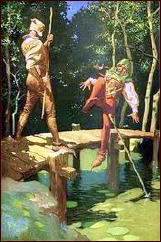
One of the few advantages of working the Midnight Shift is that I get to listen to BBC World Service Overnight on the Radio, and it’s the sort of show that rivals anything from NPR. Among the interesting features that have livened my work nights was a program on the genesis and development of the Robin Hood legend, which was so fascinating I couldn’t help recapitulating its salient points here:
Robin Hood apparently started out as just a bunch of stories about a guy who lived in Greens Wood in England; not an Outlaw, just a Hunter and all-around Doughty Woodsman.
He may be related to a nebulous character from Celtic myth and pre-history, the Green Man, who appears in some of the earliest stained-glass windows and illuminated manuscripts, although his exact nature is a mystery.
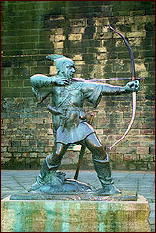
At any rate, Robin Hood came to be accepted as the name of any good woodsman, the way names like “Casanova” and “Scrooge” have slipped into Modern language, and outlaws who lived in the woods back in the early middle ages took to calling themselves that.
As tall tales of their exploits were told and re-told, they began to coalesce around someone named Robin Hood, who in those days was just a flattering portrait of Ye Merreye OuteLawe: Brave, witty, fair-minded and lovable.
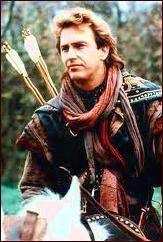
Time passed, History happened, and these worked changes on the character. Forests in England began to shrink, and the legend moved to center on the last largest extant forest, Sherwood. There was a Reeve (local administrator of the law) in that area who came from Nottingham, and he came to be called the Shire Reeve of Nottingham (say it fast).
Minstrels began making a living at the courts of nobility, and as they told the Outlaw tales to their listeners, they made the central figure more popular with the audience by saying that he was a dispossessed Nobleman, with whom many could identify in those times.
The tale made its way to France and back, and in the process picked up the Maid Marion character, along with others who represented stereotypes of the times: The lascivious Friar, the strong Woodsman (all that remained of the original character) and the romantic Minstrel.
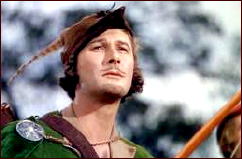
The tales were also returning to their Popular Roots, as traveling minstrels and the like began to find a market for their talents in the growing Middle Class.
Robin Hood began to figure in an early version of Trick Or Treat in which people went from house to house, decorating, dropping off little treats and occasionally making mischief. And now the final wrinkle was added to the character for the stamp of Popular Approval: Charity. Robin Hood now robbed only from the rich and gave freely to the poor.
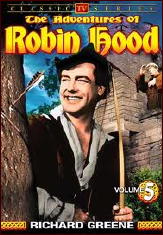
In the last analysis, the program said, Robin Hood has survived because he has represented so many things to so many times. In our Century he has been a symbol of fun-loving freedom in the 20s, anti-Nazi in the late 30s, fighter for justice in the 50s, and in the 90s a champion of fairness and tolerance.
What surprised me was that one professor said his favorite 20th Century treatment of the character was the half-hour TV show back in the 50s. In these shows, Robin was the archetypal Mythical Figure: no Origin, no beginning and no End, just a new tale to add to the legend every week, which goes back to the earliest traditions of story-telling.
January 12th, 2012 at 12:28 pm
There was also the printed version, THE MERRY ADVENTURES OF ROBIN HOOD by Howard Pyle (1883). I wonder if that book inspired the many “thief as hero” that followed and became a popular genre in turn of the century (1900, not 2000) mystery.
January 12th, 2012 at 1:49 pm
I think you’re right, Michael. It took the printed word, easily accessible to the general public, to “codify” all of the legends that had built up around the character over the years and pretty much fix it in stone from that time on.
While I was posting Dan’s piece, it reminded me a lot of what happened King Arthur, Camelot and the Round Table, which was essentially the same thing. Malory’s work, Morte d’Arthur, was written in the 15th century, but it wasn’t until Alfred, Lord Tennyson came along with Idylls of the King around the same time as Pyle, the late 19th century, that the legend became more or less permanent.
Getting back to Robin Hood, I’d have to agree with that professor who’s quoted in Dan’s last paragraph. I’ve always thought the 1950s TV version of the character was far more interesting and entertaining than the standard printed versions I’d grown up with. (I say this with the caveat that I have not seen any of the recent British TV series, nor had the professor, since Dan’s essay was written back in 1992.)
But the series took the character and wrote brand new stories about him and Maid Marion, Friar Tuck and the others, and didn’t simply keep retelling the basic ones over and over again. Back when I was young, I’d have stayed more interested in Arthur, Merlin, Lancelot and other Knights if there had been more stories of the knights’ various adventures in the surrounding countryside, and less telling of the (well) same basic ones over and over again.
January 12th, 2012 at 2:32 pm
The truth is that nobody knows how and when Robin Hood first came into existence. I have heard learned experts say that he is definitely A) a real person called Robin Hood B) a bandit whose nickname was Robin Hood C) an aristocrat called Robin Odo D) a mythical figure E) take your pick. Personally, I think that there was probably a ‘real’ person behind the legend, although how closely he resembles the myth is anyone’s guess. The Richard Greene series is great fun, and I have the full set on DVD. There is an origin story, where Hood returns from the Crusades and discovers that the bad guys have stolen his birth right. It runs for the first few episodes, and introduces most of the main characters. It’s fun to notice the swipes at bureaucracy, which would have resonated with a British audience at the time.
January 13th, 2012 at 4:25 pm
One of the most important aspects of the Robin Hood myth is the antagonism between the Anglo-Saxons and the Normans, many of the former having been killed or disposessed by the latter, and this conflict kept sweltering for centuries after 1066.
The Doc
January 13th, 2012 at 7:43 pm
Right. Kids over there have to learn a lot more history about their own country than they do here!
January 14th, 2012 at 5:01 am
One of the interesting things about the legend is the way that it has remained vital and relevant over the years. King Arthur and co are important, but they aren’t looked at in quite the same way. The idea of Robin Hood is a very strong one. Notice how The Saint is often referred to as ‘a modern day Robin Hood’; the guy who stands up for the rights of the little people remains a potent idea. Errol Flynn’s archer accentuates the idea of the freedom fighter as WWII approaches, whilst the Michael Praed/Jason Connery version taps into Green/Mystical ideas that became more popular in the 80s. One of the reasons that the recent BBC series didn’t work for me was that the makers didn’t really know what approach they wanted to take to the material, making it a fundamentally unsatisfying experience.
January 14th, 2012 at 12:06 pm
You’re saying that the “common man” (little people) identify more with Robin Hood than King Arthur. I can understand that. And I like your point that Robin Hood’s persona, if you will, can be adapted to the times more than Arthur. As I said earlier, I haven’t watched any of the recent attempts to portray Robin Hood to the small screen. Sounds as though they did so outwardly but the “updates” have failed, without managing to capture the heart of the character, as they may have (or haven’t) with the current versions of Sherlock Holmes and Miss Marple. (Some of the adaptations of the latter sound especially dreadful.)
January 14th, 2012 at 1:41 pm
Steve: The current update of Sherlock Holmes manages to keep to the spirit of the original, whilst updating the settings to right now (computer hacking, international terrorism, biological warfare, and Holmes and Watson telling everybody that they’re not a gay couple). On the other hand, the Marple keeps to the correct period but singularly fails to capture the essence of Christie’s character. A lot of it has to do with the fact that the scripters for Marple were pretty much told to do what they liked with the books, whilst the writers/producers of the Sherlock series are both huge Holmes fans from wayback.
January 14th, 2012 at 2:31 pm
Well, if I had my druthers, I’ve have kept Holmes in the proper time period and in the spirit of the original, but I won’t argue about the former if they keep the latter. (I do understand the need for commercial appeal.)
Myself, I have yet to watch either the new BBC version of Sherlock Holmes or the Marple’s. I’ve already put a higher priority on the former, which I own on DVD, given equal encouragement from others.
Miss Marple, though, I’ll probably stick with the books.
January 14th, 2012 at 2:34 pm
Real life, by the way, has disrupted my usual posting schedule, in case anyone’s been wondering. I haven’t run out of material to get online, that’s for certain; it’s only lack of time.
Look for something new later this evening!
— Steve
January 14th, 2012 at 5:21 pm
Steve, what do you mean “Real life”? You mean this isn’t real life? For most of my life, the daily routine of existence was just something to get through so I could read and collect. This is real life: your blog, collecting, reading, watching movies, attending PulpFest and Windy City, talking to and visiting other collectors, listening to music, etc.
What else is there?
I have to stop typing now because I’m reading some great ghost stories by Reggie Oliver. When I look back on my life, I see a life of reading and thinking about books and old movies. I wouldn’t want it any other way. Come to think of it, over the 40 years we’ve known each other, all our conversations have been about books or pulps. I know what you mean by “real life” but I’ll die reading a book.
January 14th, 2012 at 5:58 pm
My apologies. I know the phrase “real life” always belongs in quotes. I should have known better than to leave them out. Sorry about that. Mea culps!
January 14th, 2012 at 9:28 pm
Contrary to the article, the 1950s TV show DID feature an origin for Robin. The first episode showed him returning from the Crusades to find a bad baron stealing his land and finished with him joining the outlaws. In the second episode, he becomes the outlaw’s leader, and the next three or four episodes introduce other key characters like Little John, Maid Marian, and Friar Tuck–rather like an extended pilot.
January 14th, 2012 at 10:20 pm
This agrees with Bradstreet’s recollection in Comment #3. I’ve put off obtaining the complete series on DVD, mostly for fear it wouldn’t match up to my memories of it when I was in my early teens, but after all this discussion of it, I may change my mind.